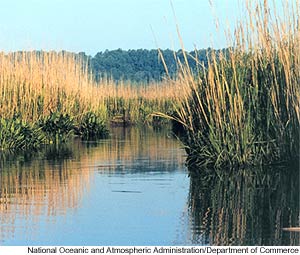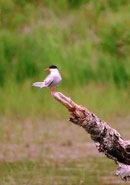| Salt Marshes
 Just
like marshes further inland, salt marshes are also wetlands. Salt water
marshes occur in places where the land meets the sea, such as barrier islands
and other coastal areas. They are exposed to water at different times of
the day or year. Sometimes the marsh has little water, sometimes it is
dry, and sometimes it is very full of water—almost like a pond. Their
salinity, or salt content, varies depending upon whether they are located
right on the ocean or further upstream in the estuary or sound. The
water level and salinity level determine which plants and animals make
their homes there. Just
like marshes further inland, salt marshes are also wetlands. Salt water
marshes occur in places where the land meets the sea, such as barrier islands
and other coastal areas. They are exposed to water at different times of
the day or year. Sometimes the marsh has little water, sometimes it is
dry, and sometimes it is very full of water—almost like a pond. Their
salinity, or salt content, varies depending upon whether they are located
right on the ocean or further upstream in the estuary or sound. The
water level and salinity level determine which plants and animals make
their homes there.
 Salt
marshes are extremely productive. Microscopic organisms like bacteria,
fungi, and algae make their home in the decaying marsh grasses. These decaying
plants and micro-organisms are then eaten by fish, worms, and crustaceans,
furthering the cycle of decomposition. The plentiful insects provide food
for birds and fish. Salt
marshes are extremely productive. Microscopic organisms like bacteria,
fungi, and algae make their home in the decaying marsh grasses. These decaying
plants and micro-organisms are then eaten by fish, worms, and crustaceans,
furthering the cycle of decomposition. The plentiful insects provide food
for birds and fish.
The vegetation of the salt marsh also provides shelter
from predators, especially for young animals who use the salt marsh as
a nursery.
| Disclaimer |
Copyright © 2003 Missouri
Botanical Garden
|
 |
|
